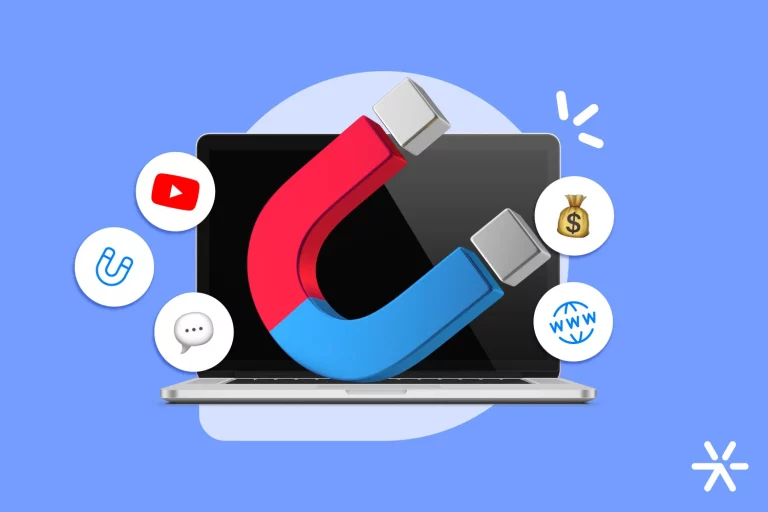Website Traffic: Types and How to Attract Qualified Traffic
Is attracting traffic to your website one of your main objectives?
You’re not alone!
This is one of the biggest challenges for marketers, who compete with numerous other websites for the attention of online users.
It’s not enough to simply bring a significant volume of visitors to the site, as there are different types of traffic that can result in lead generation and opportunity creation.
Keep reading to understand how this process works, how different types of traffic can be used, and how they lead qualified leads to your website.
What is Qualified Traffic?

Qualified traffic is the traffic that includes visitors who fit your ideal customer profile and who are interested in the content offered on your pages.
The users that make up qualified traffic may be in different stages of the sales funnel, but somehow they find something of interest on your site, such as a blog post, a rich content piece, a FAQ page, a contact form, a quote, or even a desired product or service.
Why is Qualified Traffic Important?
This is the most interesting type of traffic for marketing efforts, as these visitors are the ones that represent the return on investment.
These are the people who will stay longer on your site, help improve your site’s ranking in search engines like Google, build a relationship with the brand, become leads, and may eventually be qualified for a sales approach.
Qualified traffic has a higher potential for conversion into customers, as it meets the need, profile, and willingness to go through the entire sales funnel.
Types of Traffic a Website can Generate

Visitors to a website arrive through different stimuli and channels.
Therefore, understanding these types of traffic separately helps in understanding which strategies are working and which need improvement.
Organic Traffic
The first type of traffic to a website is organic.
This visitor arrives naturally through search platforms like Google or Bing.
Paid Traffic
Paid traffic comes from online media campaigns.
Whether on social networks or search platforms, it’s possible to invest in attracting clicks that lead to pages on your site.
Read more: Paid vs. Organic Traffic: Which Generates Better Results?
Direct Traffic
Direct traffic refers to users who type your website’s URL directly into their browser and access a page without intermediaries.
Social Traffic
Any clicks that come to your site’s pages through links shared on social networks, not through ads, are part of this type of traffic.
Referral Traffic
If there are links to your site on other websites, such as those of clients or partners, they generate what’s called referral traffic.
Email Marketing Traffic
As the name suggests, this refers to visitors who arrive at the site after clicking on a link or campaign from an email marketing campaign.

How to Attract more Visitors to your Website
Now that we’ve covered the types of traffic to your website (all of which can generate qualified traffic), it’s time to learn the tips that will bring more visitors who are genuinely interested.
1. Create Content
If you don’t have a blog yet, you can start developing this strategy to attract visitors who may not be at the end of the sales funnel yet but are interested in the content you offer.
For example, a pet store could attract animal owners with posts offering tips on how to start training their pets, the best types of collars for different sizes, or items that make pets’ lives more comfortable.
You can offer this knowledge in various formats, such as e-books, videos, tools, etc.
2. Make your Blog Relevant
To attract the desired audience, your blog needs to have posts that reflect their interests.
So, invest in easy-to-read articles, using keywords that appear in search engines and focus on providing a great experience for visitors who land there.
Make sure the content delivers what the title promises, with solid information, data, examples, and insights gathered from years of experience in your niche.
Co-marketing is also a way to increase your blog’s relevance, creating partnerships between businesses to amplify the reach of your content, campaigns, and materials to attract qualified traffic.
3. Add Social Sharing Buttons
Include social media sharing options on your pages through buttons.
For example, this post shows buttons on the right side of the page that follow the content as users navigate.
These buttons encourage visitors to share, especially if your content is of high quality.
4. Eliminate Website Errors
No one likes navigating a website with errors or long loading times.
So, this is an important point if you want to attract traffic to your site.
Eliminating errors and optimizing a website means improving structure and content factors.
This way, you increase the volume of visits, offer relevant content to your audience, enhance your brand’s online relevance, and improve conversion rates.
Check out: 5 Reasons to Improve Your Website's Speed Right Now
5. Conversion Form
Speaking of conversion, here’s another tip.
In addition to generating traffic, you, of course, want to leverage that traffic to generate qualified leads.
To do this, place hooks and ways for visitors to take the next step throughout your site.
This can be done through static forms or more modern interactive tools (like chatbots) to resolve questions, offer new content and materials, suggest receiving updates via email, etc.
6. Respond to your Audience
Interaction is one of the results that can come from increased visitor volume.
Whether through a contact form, blog comment, or interaction with a virtual assistant or chatbot, visitors expect a response.
Preferably, a quick one.
This builds relationships with visitors and encourages them to return to your site more often.
7. Review the Persona Regularly
Many businesses make the mistake of creating a persona at the beginning of their brand’s communication and treating it as fixed and unchanging.
Just as the brand evolves over time, so does the consumer of your solution.
That’s why reviewing the persona is so important.
This review doesn’t mean that your audience will be completely different, but that your brand cares about understanding their new needs and desires.
This review also includes understanding new tools they may be using and how these tools are transforming their consumption habits.
Updating the persona should come with an update of the strategies planned for them.
How to Analyze the Effectiveness of your Strategies to Generate Qualified Traffic?

Some metrics help track your website’s traffic.
They are:
Lead Generation Quantity
The number of leads generated through the website is the first indication of the quality of the traffic.
This is because you may have a high volume of visitors, but if you have low conversion, one of two things is true:
- You need to improve the website’s conversion hooks;
- You need to improve the quality of traffic, as visitors aren’t interested in going through your sales funnel.
Total Traffic and Bounce Rate
Total traffic shows the number of visitors who access your pages.
Another metric tied to this is the time spent on the page, which search platforms use to gauge the relevance of your content based on the experiences of visitors who’ve already accessed it.
A low time on page or a high bounce rate negatively impacts your site’s results.
Return on Investment (ROI)
ROI stands for “Return on Investment.”
This is one of the most important metrics for a company and deserves your constant attention and monitoring.
For your website, ROI calculates how much was invested to attract visitors vs. how much these visits resulted in sales or contracts.
This allows you and your team to have control over the results of campaigns, actions, and new marketing strategies implemented.
Conversion Rate
The conversion rate, in the case of your site, is the ratio between the number of visitors and the number of leads generated through the pages.
There’s no single ideal rate, as it varies depending on the industry, content offered, and the stage of the sales funnel.
Learn more about this metric in the post “Conversion Rate Benchmark by Market Segment.”
Attract Traffic to Your Site Strategically
In addition to the volume of visitors, focus on attracting those who match your desired profile.
That way, you build relationships with relevant opportunities for your commercial sector!








